Since the beginning of this year, a series of technology car, delivery, and taxi companies have been racing to switch to using electric vehicles to transport people and deliver goods.
On May 18, Dat Bike's Weaver++ electric vehicles began being used by some Gojek drivers to transport people, deliver goods and food. According to Gojek's calculations, using electric vehicles helps reduce fuel costs by more than 4 times compared to gasoline vehicles, and on the other hand, contributes to protecting the environment by stopping emissions.
Previously, the first 10 shippers of the food delivery app Baemin also started delivering goods by electric vehicles in Ho Chi Minh City. Mr. Jinwoo Song, General Director of Baemin Vietnam, said the decision to test electric vehicles aimed to popularize a green lifestyle for consumers and contribute to the Government 's goal of zero net emissions by 2050.
For the same reason, in November 2022, Lazada Logistics tested using two-wheeled electric pickup trucks. Lazada Logistics Director Vu Duc Thinh said that transporting by electric vehicles brings optimal efficiency. By the end of April, this unit was operating 100 test vehicles stably and will maintain it until the end of the year before planning to expand.
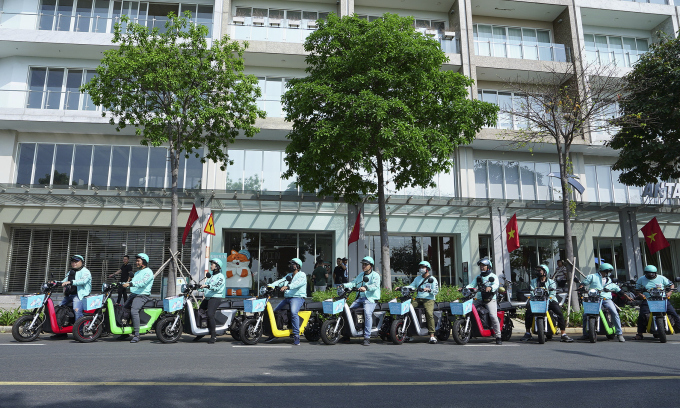
Baemin's first drivers receive electric cars. Photo provided by the company
Not only electric two-wheelers, the trend of switching to electric cars is even more bustling. At the end of 2021, VinBus launched the first electric bus route in Vietnam in Hanoi , up to now there are 8 routes. In early March last year, they also opened a route in Ho Chi Minh City.
Recently, electric taxis have also flourished. In mid-April, 500 electric taxis appeared in Hanoi, operated by GSM Green and Smart Mobility Joint Stock Company. Currently, the company's electric taxis are also present in Ho Chi Minh City. General Director Nguyen Van Thanh set a target of having about 10,000 vehicles in the localities.
The GSM initiative quickly spread to other companies. At the end of April, Golden Swallow signed a contract to buy 25 cars from VinFast and lease 125 cars from GSM to operate as taxis in Hai Phong. Electric taxis have also appeared in Lam Dong, operated by Lado.
What's driving the race to switch to electric vehicles?
First is the general trend in the region. Transport and logistics companies in Thailand, Taiwan and Indonesia are all accelerating their plans to develop electric vehicles and have a roadmap to convert to 100% by 2035.
In China, most drivers for Meituan, the country’s largest food delivery platform, and smaller rivals use electric bicycles or scooters. The country’s first electric taxi service was launched in Shenzhen in May 2010. According to Interact Analysis, a British market research firm, sales of electric buses and vans will hit a record 238,000 in 2022, up 90% from 2021. Buses will account for 58% of the total, with 138,000.
In Southeast Asia, the pressure of pollution from the transport sector in the digital economy is growing, forcing businesses to join in. The E-conomy 2022 report by Google, Temasel, Bain & Company said that transport, food delivery and e-commerce activities will increase CO2 emissions from 6 tons last year to 20 tons by 2030.
In the online transportation sector alone (the delivery of goods and people from app-based requests), the report suggests that emissions could be reduced by 20-30% by switching to electric vehicles, combined with optimizing driving routes.
Explaining the use of electric vehicles, Mr. Sumit Rathor, General Director of Gojek Vietnam, said the project is a step in GoTo Group's "three zero" commitment (zero emissions, zero waste, zero barriers) in reducing emissions and converting operating vehicles to 100% electric vehicles.
Next, the gradual improvement of policies is also a favorable condition for Vietnam to promote the use of electric vehicles. In July 2022, the Government approved the Action Program on green energy conversion, reducing carbon and methane emissions in the transport sector. The program aims to completely switch to electric buses by 2025 and electric taxis by 2030. By 2050, 100% of road motor vehicles will be electric vehicles.
Mr. Dao Xuan Lai, Assistant Resident Representative and Head of Climate Change and Environment Unit of UNDP in Vietnam, recently commented that the transport sector accounts for a quarter of Vietnam's emissions, so this sector is extremely important in achieving the carbon neutrality target, along with construction and industry.
Third, Vietnamese people's sympathy for electric vehicles is gradually improving. Motorcyclesdata - the world's leading motorcycle review website - announced that the growth rate of electric motorcycle sales in Vietnam in 2021 was 10%, triple that of 2018 (2.9%), showing a rapid growth trend despite the impact of the pandemic.
A survey in Hanoi, Hai Phong, Da Nang, Ho Chi Minh City, Can Tho, Quang Ninh, Thua Thien - Hue, Phu Yen by the Association of High Quality Vietnamese Goods Enterprises and UNDP in Vietnam also showed that about a quarter of respondents want to increase the frequency of using electric bicycles and electric motorbikes. The rate for electric cars is even higher, up to 61%.
Finally, popularizing electric vehicles in transportation services is also a way to promote products. Dat Bike CEO Son Nguyen said that the force of technology driving partners is large and they are people who need to use vehicles with high frequency. Therefore, cooperating with technology companies helps car manufacturers have another way to "convince more users". It can be seen similarly with GSM, where VinFast can introduce products on a wider scale.
What is the future of electric vehicle transportation?
It will take time for delivery companies to release test results, but several studies on electric vehicle conversions in Vietnam show promise.
Two experts Nguyen Huu Duc and Nguyen Ngoc Van, Faculty of Energy Technology and Faculty of Electricity, University of Electricity, said that the conversion to electric vehicles in the 2-wheel group will be more promising than 4-wheel, because the income of most people is not high, urban roads are narrow and parking is lacking.
“With very high rates of ownership of petrol-powered motorbikes in major cities, the immediate potential for electrification of road transport, especially in urban areas, lies in electric two-wheelers,” the group of experts commented.
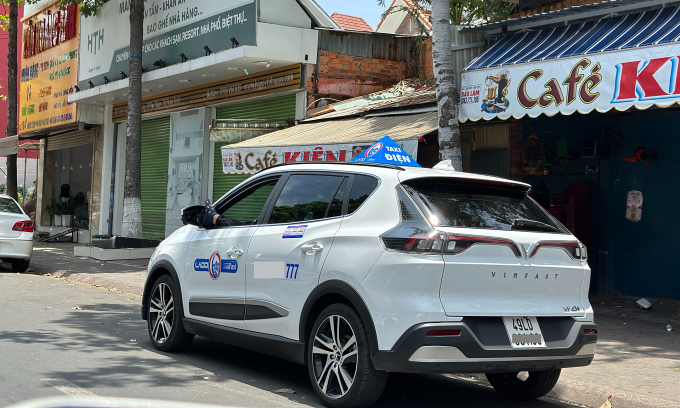
An electric taxi with a Lam Dong license plate stops to wait for passengers on Ton Duc Thang Street, Phan Thiet, Binh Thuan on April 30. Photo: Vien Thong
For 4-wheel electric vehicle services, the future is more challenging because the current charging station system is not enough to meet the needs of battery charging and battery exchange, especially in suburban areas.
According to Mr. Le Trung Tin, Chairman of the Ho Chi Minh City Passenger Automobile Transport Association, the time to charge an electric car is longer than filling up with gasoline or diesel. The price of an electric car is 1.3-1.5 times higher than the price of a similar car running on fossil fuels. In return, the cost of electricity is cheaper, the supply is also abundant, and it is less affected by world fuel prices.
At the Shareholders' Meeting on April 25, Ho Chi Minh City taxi "tycoon" Vinasun also said that the calculation for switching to electric vehicles will depend on the progress of the charging station network development and charging time.
Therefore, experts believe that to accelerate the electric vehicle transportation service, there needs to be a subsidy plan for people or businesses when investing in the conversion. On the other hand, incentives can come from input prices - electricity prices.
"The market has great prospects. The problem is that businesses and the Government coordinate to convert potential numbers into actual numbers," said Mr. Hoang Trong, expert of the Association of High-Quality Vietnamese Goods Enterprises, representative of the research group on the electric vehicle market with UNDP Vietnam.
Mr. Vo Tan Thanh, Vice President of the Vietnam Federation of Industry and Commerce - VCCI, commented that consumers now not only want cheap prices and good quality but also demand environmental friendliness. They are increasingly wiser and smarter. "Electric vehicles are a global trend, and Vietnam cannot stand outside it," he said.
However, electric taxi services are likely to face a test of quality versus price for passengers. For example, SM Green Taxi fares are slightly higher than traditional taxis and technology taxis.
Ms. Thu Ha took an electric taxi from Hoang Quoc Viet (Cau Giay) to Phuong Canh (Nam Tu Liem) on April 15 for 128,000 VND, while she saw on technology-based ride-hailing apps that the cheapest fare after promotions was only 50,000 VND. However, she chose an electric taxi to experience it.
"The car is new, clean and the driver is polite. Notably, it runs smoothly and has no smell, so my child doesn't get carsick like when taking a regular taxi. But the price is twice as much as a ride-hailing car, which makes me think again," said Ms. Thu Ha.
Telecommunications
Source link


![[Photo] Lam Dong: Images of damage after a suspected lake burst in Tuy Phong](https://vphoto.vietnam.vn/thumb/1200x675/vietnam/resource/IMAGE/2025/11/02/1762078736805_8e7f5424f473782d2162-5118-jpg.webp)
![[Photo] Prime Minister Pham Minh Chinh chairs the second meeting of the Steering Committee on private economic development.](https://vphoto.vietnam.vn/thumb/1200x675/vietnam/resource/IMAGE/2025/11/01/1762006716873_dsc-9145-jpg.webp)








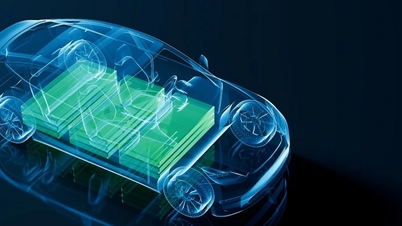
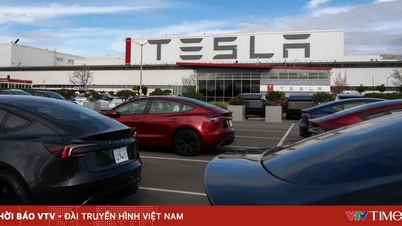

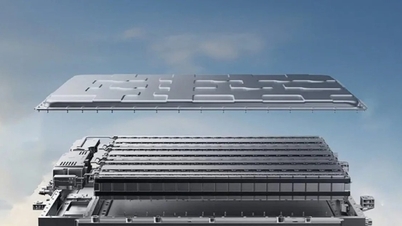











































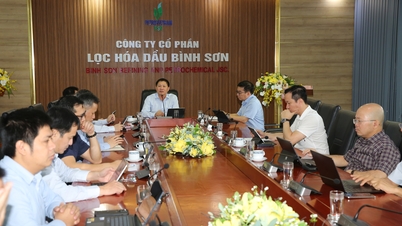
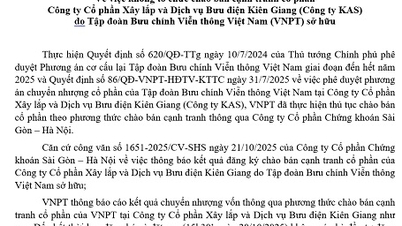















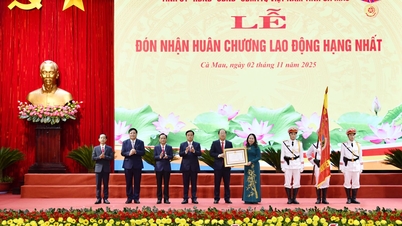
































Comment (0)